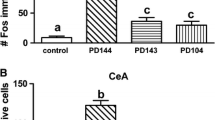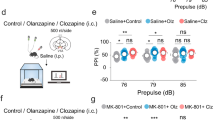Abstract
Rationale
Typical and atypical antipsychotic drugs produce characteristic patterns of immediate early gene expression in rat forebrain that are considered to reflect their effects in schizophrenia subjects.
Objective
To use c-Fos immunohistochemistry to investigate the functional neuroanatomical profile of the newly introduced atypical agent ziprasidone.
Materials and methods
c-Fos immunohistochemistry was performed on paraformaldehyde-fixed cryosections of rat brains obtained, initially, from animals 2, 4, or 6 h after oral administration of 10 mg/kg ziprasidone or vehicle and, subsequently, from animals 2 h after oral administration of 1, 3, or 10 mg/kg ziprasidone or vehicle. The density of immunoreactive nuclei was assessed in pre-determined forebrain regions.
Results
Ziprasidone induced a time-dependent increase in the density of c-Fos-positive nuclei that was maximal at 2 h. At the 2 h time-point, c-Fos expression was significantly (p<0.05) elevated in the shell and core of the nucleus accumbens, lateral and medial caudate putamen, and lateral septum. At 4 h post-dose, c-Fos expression was also significantly increased in the cingulate gyrus. Ziprasidone-induced c-Fos expression was dose-dependent with significant (p<0.05) c-Fos expression observed in the nucleus accumbens (shell and core) and caudate putamen (lateral and medial) at 3 and 10 mg/kg and in the lateral septum at 10 mg/kg.
Conclusions
Increased c-Fos expression in the nucleus accumbens and lateral septum is considered to be predictive of activity against positive symptoms, in the caudate putamen of motor side effect liability, and in the cingulate gyrus of efficacy against negative symptoms. Thus, the observed pattern of c-Fos expression induced in rat brain by ziprasidone is consistent with its reported clinical effects, namely, efficacy against positive symptoms with a therapeutic window over motor side effects and with some activity against negative symptoms.






Similar content being viewed by others
References
Bantick RA, Deakin JFW, Grasby PM (2001) The 5-HT1A receptor in schizophrenia: a promising target for novel atypical neuroleptics? J Psychopharmacol 15(1):37–46
Cropley J, Gibson V, Rourke C, Hatcher P, Jones D.N.C, Reavill C (2003) Pharmacological profile of atypical antipsychotic drugs. J Psychopharmacol 17 Suppl 3
Daniel DG, Zimbroff DL, Potkin SG, Reeves KR, Harrigan EP, Lakshminarayanan M (1999) Ziprasidone 80 mg/day and 160 mg/day in the acute exacerbation of schizophrenia and schizoaffective disorder: a 6 week placebo controlled study. Neuropsychopharmacology 20:491–505
Daniel DG, Copeland LF (2000) Ziprasidone: a comprehensive overview and clinical use of a novel antipsychotic. Expert Opin Invest Drugs 9(4):819–828
Deutch AY, Lee MC, Iadorola MJ (1992) Regionally specific effects of atypical antipsychotic drugs on striatal Fos expression: the nucleus accumbens shell as a locus of antipsychotic action. Mol Cell Neurosci 3:332–341
Deutch AY (1996) Sites and mechanism of action of antipsychotic drugs as revealed by immediate early gene expression. In: Csernansky JG (ed) Antipsychotics. Springer, Berlin Heidelberg New York, pp117–161
Dragunow M, Robertson GS, Faull RL, Robertson HA, and Jansen K (1990) D2 dopamine receptor antagonists induce Fos and related proteins in rat striatal neurons. Neuroscience 37:287–294
Gunasekara NS, Spencer CM, Keating GM (2002) Ziprasidone: a review of its use in schizophrenia and schizoaffective disorder. Drugs 62(8):1217–1251
Habara T, Hamamura T, Miki M, Ohashi K, Kuroda S (2001) M100907, a selective 5-HT2A receptor antagonist, attenuates phencyclidine-induced Fos expression in discrete regions of rat brain. Eur J Pharmacol 417(3):189–194
Invernizzi RW, Cervo L, Samani R (1988) 8-Hydroxy-2-(di-N-propylamino) tetralin, a selective serotonin1A receptor agonist, blocks haloperidol induced catalepsy by an action on raphe nuclei medianus and dorsalis. Neuropharmacology 27(5):515–518
Jongsma ME, Sebens JB, Bosker FJ, Korf J (2002) Effect of 5-HT1A receptor-mediated serotonin augmentation on Fos immunoreactivity in rat brain. Eur J Pharmacol 455(2–3):109–115
Kapur S, McClelland RA, VanderSpek SC, Wadenberg ML, Baker G, Nobrega J, Zipursky RB, Seeman P (2002) Increasing D2 affinity results in the loss of clozapine’s atypical antipsychotic action. Neuroreport 13(6):831–835
Kovacs KJ, Csejtei M, Laszlovszky I (2001) Double activity imaging reveals distinct cellular targets of haloperidol, clozapine and dopamine D3 receptor selective RGH-1756. Neuropharmacology 40(3):383–393
Mansbach RS, Carver J, Zorn SH (2001) Blockade of drug induced deficits in prepulse inhibition of acoustic startle by ziprasidone. Pharmacol Biochem Behav 69:535–542
Meltzer HY, Matsubara S, Lee JC (1989) Classification of typical and atypical antipsychotic drugs on the basis of dopamine D1, D2 and serotonin2 pKi values. J Pharmacol Exp Ther 251:238–246
Merchant KM, Figur LM, Evans DL (1996) Induction of c-fos mRNA in rat medial prefrontal cortex by antipsychotic drugs: role of dopamine D2 and D3 receptors. Cereb Cortex 6(4):561–570
Paxinos G, Watson C (1997) The rat brain in stereotaxic coordinates. Academic, San Diego, California, USA
Reavill C, Kettle A, Holland V, Riley G, Blackburn TP (1999) Attenuation of haloperidol-induced catalepsy by a 5-HT2C receptor antagonist. J Psychopharmacol 126:572–574
Robertson GS, Fibiger HC (1992) Neuroleptics increase c-fos expression in the forebrain: contrasting effects of haloperidol and clozapine. Neuroscience 46:315–328
Robertson GS, Matsumura H, Fibiger HC (1994) Induction patterns of Fos-like immunoreactivity in the forebrain as predictors of atypical antipsychotic activity. J Pharmacol Exp Ther 271:1058–1066
Schmidt AW, Lebel LA, Howard HR Jr, Zorn SH (2001) Ziprasidone: a novel antipsychotic agent with a unique human receptor binding profile. Eur J Pharmacol 425:197–201
Schwartz JC, Diaz J, Pilon C, Sokoloff P (2000) Possible implications of the dopamine D3 receptor in schizophrenia and in antipsychotic drug actions. Brains Res Rev 31:277–287
Sebens JB, Kuipers SD, Koch T, Ter Horst GJ, Korf J (2000) Limited participation of 5-HT1A and 5-HT2A/2C receptors in the clozapine-induced Fos-protein expression in rat forebrain regions. Eur J Pharmacol 408(1):11–17
Seeger TF, Seymour PA, Schmidt AW, Zorn SH, Schulz DW, Lebel LA, Mclean S, Guanowsky V, Howard HR, Lowe JA, Heym J (1995) Ziprasidone (CP-88,059): a new antipsychotic with combined dopamine and serotonin receptor antagonist activity. J Pharmacol Exp Ther 275:101–113
Sumner BE, Cruise LA, Slattery DA, Hill DR, Shahid M, Henry B (2004) Testing the validity of c-Fos expression profiling to aid the classification of psychoactive drugs. Psychopharmacology 171(3):306–321
Tremblay P-O, Gervais J, Rouillard C (1998) Modification of haloperidol-induced pattern of c-Fos expression by serotonin agonists. Eur J Neurosci 10:3546–3555
Wadenberg ML (1992) Antagonism by 8-OH-DPAT, but not ritanserin, of catalepsy induced by SCH23390 in the rat. J Neural Transm 89:4–9
Wan W, Ennulat DJ, Cohen BM (1995) Acute administration of typical and atypical antipsychotic drugs induces distinctive patterns of Fos expression in the rat forebrain. Brain Res 688(1–2):95–104
Author information
Authors and Affiliations
Corresponding author
Rights and permissions
About this article
Cite this article
Jennings, C.A., Cluderay, J.E., Gartlon, J. et al. The effects of ziprasidone on regional c-Fos expression in the rat forebrain. Psychopharmacology 184, 13–20 (2006). https://doi.org/10.1007/s00213-005-0222-1
Received:
Accepted:
Published:
Issue Date:
DOI: https://doi.org/10.1007/s00213-005-0222-1




